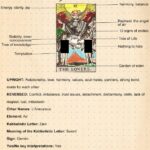Tarot cards have enchanted seekers and practitioners alike for centuries. They serve as a potent link to our subconscious, unearthing the profound symbolism entrenched within human experience. The intricate tapestry woven by the Tarot is enriched by a multitude of cards, each imbued with unique meanings and archetypes, collectively guiding us through introspection and revelations. In this article, we will explore the multifaceted meanings of the Tarot cards, focusing particularly on how readers interpret and apply these meanings in their spiritual practices.
To understand the essence of Tarot, it is crucial to analyze the structure of a Tarot deck. A standard deck consists of 78 cards, divided into two primary sections: the Major Arcana and the Minor Arcana. The Major Arcana encompasses 22 cards, each representing significant life events, spiritual lessons, and transformative experiences. The Minor Arcana, on the other hand, is composed of 56 cards divided into four suits: Cups, Swords, Wands, and Pentacles. Each suit epitomizes different aspects of daily life, from emotions to actions and material concerns.
The Major Arcana cards, often regarded as the heart of the Tarot, are typically interpreted as representing profound themes in one’s journey. For instance, The Fool card signifies new beginnings, spontaneity, and potential, beckoning individuals to embrace the unknown. In contrast, The Tower represents upheaval and chaos, symbolizing the necessity for change, albeit through tumultuous experiences. Tarot practitioners often delve deep into these archetypes, drawing connections with the querent’s current life situation to provide insights and guidance.
The Minor Arcana, though considered to address day-to-day issues, is no less significant in its impact. Each suit serves a specific function in the tableau of life experiences. For instance, Cups occupy a space of emotional depth and relationships, illustrating the nuances of love, empathy, and intuition. An interpretation of the Five of Cups might evoke feelings of loss, urging the querent to acknowledge their sorrow while also prompting them to recognize the opportunities still present in their surroundings.
Moving to the suit of Swords, this segment illustrates intellectual pursuits, communication, and conflict. Cards such as the Ace of Swords signify breakthroughs and clarity, while the Three of Swords often represents heartbreak or emotional pain. Utilizing these symbols, Tarot readers can guide individuals through turbulent thoughts, fostering self-reflection and clarity to surmount mental challenges.
Wands convey themes of ambition, creativity, and action. A positive card like the Eight of Wands suggests swift progress or movement, while the Four of Wands embodies celebrations and stability in community or family. Readers often utilize these correlations to inspire practicality in pursuing career goals or personal aspirations.
Finally, the suit of Pentacles addresses material wealth, health, and practicality. The Ten of Pentacles suggests generational wealth and long-term success, while the Five of Pentacles symbolizes financial struggle or hardship. Through these narratives, practitioners provide querents with insight into their financial wellbeing and practical matters, enhancing their understanding of abundance and prosperity.
Beyond the individual card meanings, Tarot readings involve various layouts or spreads. The most well-known is the Celtic Cross, which offers an overview of one’s situation through a ten-card layout. Each position in this spread holds a specific significance, helping both the reader and the querent explore their questions from multiple perspectives. A three-card spread is another popular choice, often utilized for clarity on past, present, and future scenarios. This compact approach allows for quick insights without overwhelming the querent.
Many Tarot readers also infuse their personal philosophy and intuitive abilities into their interpretations. This aspect of Tarot reading is immensely subjective, engaging the reader’s emotional intelligence, life experience, and spiritual acuity. This connection between reader and querent is what often transforms a mere card reading into a holistic experience of self-discovery and empowerment.
The role of symbolism is indispensable in exploring Tarot card meanings. Each card is laden with imagery that elicits instinctive responses. A Tarot reader may analyze symbols, colors, and even numerology to deepen the interpretative process. For instance, a reader might focus on the image of a bird in flight within a card, symbolizing freedom and perspective, thereby encouraging the querent to transcend their immediate challenges.
Engaging in Tarot also emphasizes the importance of questioning. Skillful readers often pose probing questions, inviting querents to delve into their inner worlds, and facilitating self-exploration. This dialogue not only enriches the reading but also empowers individuals to draw conclusions independently, making the interpretation a co-created experience.
Ultimately, the meanings embedded in Tarot cards extend far beyond divination. They touch upon the very essence of human existence: the struggle for understanding, the quest for direction, and the pursuit of personal evolution. Readers immerse themselves into this vast ocean of symbolism and narrative, providing guidance that is reflective, transformative, and deeply personal. The journey through the realm of Tarot promises not only revelations but also an enriched comprehension of the self and the universe’s intricate dance.
In summation, the exploration of Tarot card meanings is a rich and dynamic experience that invites a multitude of interpretations, connecting seekers to their deeper selves. Whether addressing transformative life events or daily life challenges, Tarot serves as a mirror reflecting the complexities of the human experience.






Leave a Comment